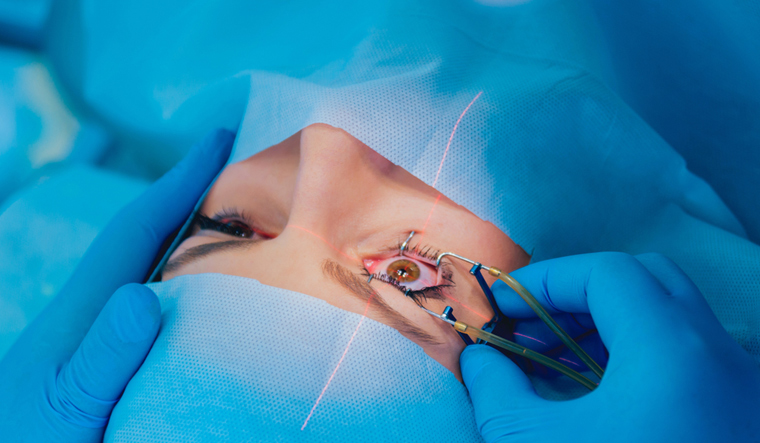The eye surgery LASIK treatment is one of the most frequently done forms of laser eye surgery today. It is used to correct a wide variety of visual problems, including astigmatism, farsightedness, and nearsightedness. Many individuals, understandably, have concerns about this process, with “Are you awake during eye surgery LASIK?” being one of the most commonly questioned.

Yes, you will be awake throughout the LASIK eye surgical treatment. Certain individuals think that since they are receiving medical treatment, they will be sedated and put to sleep. Despite this, laser surgery, unlike other forms of surgery, takes only a few minutes to accomplish.
You are also do not need to be awake. Your laser eye surgeon will numb the eyes with local anesthetic eye drops prior to performing the laser surgery. To assist you in relaxing and putting you at rest, your surgical team will explain what they are doing while they do the procedure.
The overall time required to complete both eyes is not long. Many individuals are astonished at how quick, painless, and quick the eye surgery LASIK process was and, even if they had qualms or anxieties prior to the treatment, they are pleased they had it done. They will frequently never have to bother about contacts or glasses again!
What Happens If I Move or Blink During LAISK Eye Surgery?
While some may anticipate lasers blasting out of the ceiling and spinning out of control if they move, cough, sneeze, or even blink, the procedure is not nearly as frightening as their imaginations suggest. To begin, you will lie comfortably with your head supported.
Following that, your laser eye surgeon will secure the eyelid in place and out of the way with a unique blinking retainer. You have nothing to fear, thanks to their state-of-the-art laser eye surgery technology, which can track the eye’s motions at rates of 4,000+ times per second.
Your laser eye surgeon’s surgical equipment is extremely precise and accurate. Eye surgery LASIK is one of the most effective surgical procedures available today, with low risks and few adverse effects. Your LASIK eye surgery will be completed in the time it takes for you to think about what may go wrong.
What to Expect in the Post-Operative Period
Following that, you may notice your eyesight becoming foggy or fuzzy. This is quite typical. Within the following 24 to 48 hours, your eyesight will begin to improve. The next day, a follow-up visit is scheduled to check your eyesight and confirm that everything is developing as planned.
Following your eye surgeon’s instructions and using any recommended drugs or eye drops as advised is a necessary part of your rehabilitation. You should refrain from rubbing or touching your eyes until they have healed.
You may even be astonished to find that your vision has improved to 20/20 or, in some circumstances, even better at follow-up sessions. However, not everyone gets this amount of improvement due to a number of variables such as present visual difficulties, overall health, and so on.
What are the various causes of a patient’s eyesight deteriorating following eye surgery LASIK?
Several of the causes are quite uncommon. Others are more prevalent. Numerous are almost certain. The majority may be discovered prior to surgery using appropriate screening tests:
1. Presbyopia:
This is the primary one that is assured. When we are children, the lens of the eye is capable of focusing both far and near. At the age of 40, the lens becomes less flexible, and near vision steadily deteriorates. This is why individuals over the age of 40 use reading glasses, bifocals, or trifocals to see clearly up close. A remedy for this is a procedure called Monovision eye surgery LASIK, which corrects one eye for distant vision and the other eye for near vision.
2. Cataracts:
This is the second and absolutely certain explanation. All humans, if they live long enough, will acquire cataracts as a natural part of the aging process. This is a lens clouding that causes blurry, hazy vision and is related to visual disturbances such as glare, starbursts, and haloes. Fortunately, this may be resolved with Cataract surgery. With the introduction of new multifocal lens implants, such as the ReSTOR and Crystalens, vision may be corrected for both near and far, hence obviating reason #1.
3. Progressive Myopia:
Nearsightedness often stops growing in the early twenties. Myopia can proceed to the ’40s or ’50s in certain cases. If your nearsightedness worsens following eye surgery LASIK, your vision will become blurry. To treat residual myopia, enhancement surgery may be required. You can read about Three advanced steps to carry out eye surgery by clicking here.
4. Farsightedness:
Eye surgery LASIK is more difficult to perform on farsighted individuals than on nearsighted people. Farsightedness often worsens with age in the majority of sufferers. Patients who are farsighted are more prone to require enhancement surgery.
5. Keratoconus Types:
Keratoconus is a congenital corneal condition that causes gradual corneal thinning and increased astigmatism. Patients suffering from full-blown Keratoconus patients should never get eye surgery LASIK since it will exacerbate the illness. Regrettably, there is no accurate test for diagnosing subclinical forms of the disease at the moment. Risk stratification is the only solution. If you are at risk of developing subclinical Keratoconus, you have two options: PRK or no Corneal surgery. Corneal transplantation can be used to treat patients with symptomatic Keratoconus.
6. Swollen Eyes:
When the LASIK flap is created, the nerves that feed the cornea are briefly disrupted. Typically, these nerves regrow within the first 3-6 months following eye surgery LASIK. During this time period, the eyes tend to be dry, which might result in hazy or fluctuating vision. If your eyes are dry prior to eye surgery LASIK, you may require intensive dry eye treatment with punctual plugs or Restasis eye drops. Another possibility is to try PRK, which is less drying. Patients who suffer from extremely dry eyes or collagen vascular illnesses such as Sjogren’s syndrome or rheumatoid arthritis should avoid eye surgery LASIK. Additional tips may be found on our Dry Eye page.
7. Huge Pupils:
When we are children, our pupils are large. They gradually lose size as they mature. It is hypothesized that having huge individuals may enhance the chance of patients developing vision problems.
8. Diabetes:
If you get diabetes later in life, your eye prescription may alter. If blood sugar levels stay excessive for an extended period of time, it can result in damage to the retina known as Diabetic Retinopathy. Diabetic retinopathy is the leading cause of blindness in working-age people. Fortunately, if blood sugars are immediately managed, the eye prescription returns to normal. Visit https://www.healthypeople.gov/2020/topics-objectives/topic/diabetes to read more about Diabetes.
9. Macular Degeneration:
As people age, they are at an increased risk of developing a condition called macular degeneration.
10. Other Eye Diseases:
Eye surgery LASIK does not confer immunity from eye illness. Eye surgery LASIK patients continue to be at risk for eye problems that might cause blindness or vision loss in non-LASIK patients.




